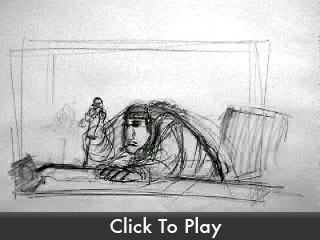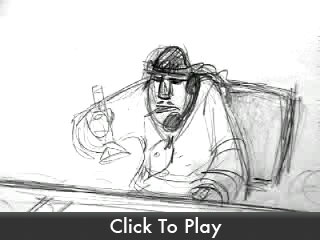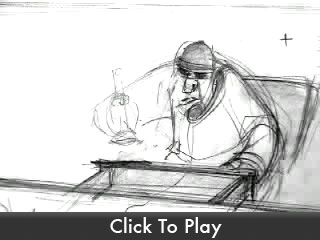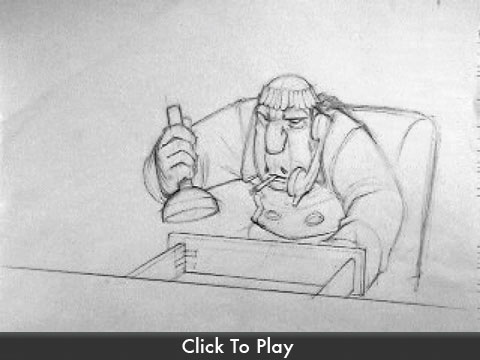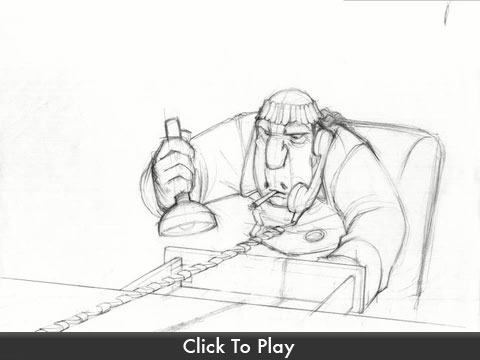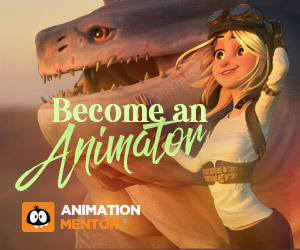BJ Crawford
Interview conducted by Eric Scheur
I loved seeing everyone's entries this month! With a sound clip that nearly begs for some kind of fun interpretation, there were so many wonderful interpretations of what the mysterious "something" the main character was talking about. It's one of my favorite things about the 11 Second Club competition: the variety of ideas that the audio inspires in people. Well done, everyone!
The animator who came out on top was BJ Crawford, who also won the June Competition. It's always exciting to see a previous winner come back to compete again, not the least reason of which is that I get the opportunity to follow up on ideas and concepts explored in the previous interview. I am happy to say hat BJ didn't disappoint.
I hope you enjoy reading our second interview with BJ Crawford. And for those CG animators who are interested in trying your hand at 2d animation, stay tuned until the end of the interview: BJ discusses his process in detail. A must read!
Until next month, my friends!
- Eric
I loved seeing everyone's entries this month! With a sound clip that nearly begs for some kind of fun interpretation, there were so many wonderful interpretations of what the mysterious "something" the main character was talking about. It's one of my favorite things about the 11 Second Club competition: the variety of ideas that the audio inspires in people. Well done, everyone!
The animator who came out on top was BJ Crawford, who also won the June Competition. It's always exciting to see a previous winner come back to compete again, not the least reason of which is that I get the opportunity to follow up on ideas and concepts explored in the previous interview. I am happy to say hat BJ didn't disappoint.
I hope you enjoy reading our second interview with BJ Crawford. And for those CG animators who are interested in trying your hand at 2d animation, stay tuned until the end of the interview: BJ discusses his process in detail. A must read!
Until next month, my friends!
- Eric
In our last interview, you talked about how you used the VCR to learn how to draw characters and identify animators with their work when you were growing up. Then you talked about getting into Sheridan College. Talk a bit about the time in between. Did you always know that you wanted to be an animator?
I have a pretty boring story. I never really changed what I wanted as a career. Before I decided on animation (around 10 years old) I had my heart set on being a truck driver. So I guess I traded a passion for turning a steering wheel into a passion for turning an animation disc. Once I decided on animation, I applied it to every single school assignment I could. Once for a trigonometry project, I animated a walk cycle and broke it down by frames, seconds, drawings, etc. I stretched the numbers out as far as I could on that project.
In college, you fell in love with the musicals of Stephen Sondheim. In the late 90's, I got to see a revival of Sunday In the Park with George in Washington DC--they used the original costumes from the Broadway production, which were all made up of pointillist pieces of fabric to match the Seurat style--very cool to see! What is your favorite musical of his, and why?
That's amazing! Any artist should listen to the score for Sunday in the Park with George. The first words of the show are "White. A blank page or canvas. The challenge: bring order to the whole...." How could you not want to experience a show that starts like that?!!
My great friend who introduced me to Sondheim prefers the [James] Lapine musicals like Sunday, Into the Woods, and Passion, but I'm more into the [Harold] Prince musicals like Sweeney Todd, Pacific Overtures, and A Little Night Music. I've seen Sweeney Todd at least 5 times and the smaller the production the better it seems to be. Plus, the smaller the theater the more likely it is that you'll get sprayed by blood during the shaving scenes.
You organized a film festival at the Portage Theater while you were living in Chicago. Can you tell us a little more about that experience?
I found the entire experience to be very rewarding, but I would never do it again.
There are so many things to consider when planning a festival. These days anyone can throw a "film festival" together on Without a Box, charge big entry fees, and then show a DVD of the films in their bedroom apartment (this has happened, by the way). I learned that these films are someone's baby and they need to be treated as such. I had three backup plans for the media we were screening that night. We did two trial runs, and in the end the color balance was still off on a few of the films. It's a horrifying feeling, because it's your responsibility to make everything screen perfectly.
The reception was very positive, and I still consider the festival a great success, but man, what pressure.
A few months ago, you had just gone through a run of watching a string of Martin Scorcese movies. What have you been watching recently?
That was a fantastic string of movies to watch. I've been watching animation more than anything else lately. Mostly Disney and Bluth.
On to your winning entry for August. There was a lot of positive reaction to your concept of the thief discovering the missing half of a torn document.
I struggled with the concept. I knew I wanted a guy speaking on the phone and I wanted him at a desk. And to make it interesting for myself, I put him in a swivel chair and placed the phone between his ear and his shoulder. That was my starting point. And it took some brainstorming with a friend to really come up with the narrative. But once she suggested finding another part of a map, then the rest of the staging and story flowed from that. It's a really nice solution to the challenge of showing character development along with set up and pay off and keeping it under 15 seconds.
How did you come to the design of the character itself?
I looked at a lot of Will Eisner characters for what communicated the best idea of a thief-type character.
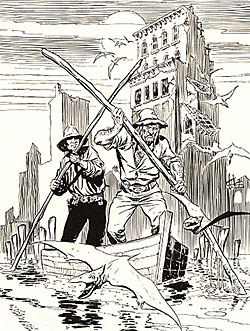
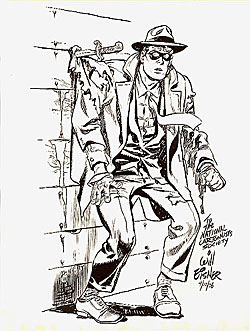
I was also trying to throw any design element in there to try and communicate the idea that it wasn't his desk. Once I finished with the animation I looked at the design and noticed that it was a version of my Pepper character from A Time for All Seasonings. Sigh. The more you try and be different...
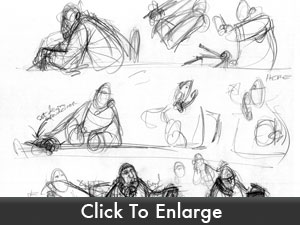
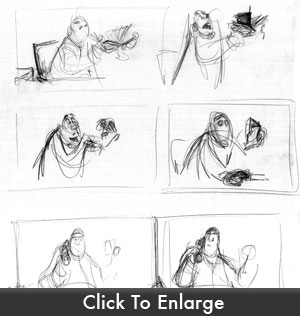
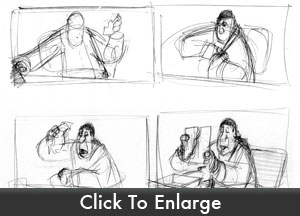
Based on your original blocking, I'm curious how the knife turned into the flashlight.
I thought the knife read very poorly. It was originally a screwdriver. I knew from the first pass I would have a problem with clarity in that first section. And I didn't want to have an issue with clarity right from the opening frame. So the flashlight ended up communicating the idea of a thief much quicker and clearer. It 's great because once you set a flashlight down on a desk, there is still potential for more animation from the object.
From what we've seen of your animation, you always have very specific acting beats and poses, and yet everything flows naturally and never feels like your character is simply hitting poses. How do you come to your acting choices and keep that natural sense of flow?
There is an interview with Milt Kahl out there somewhere where he's talking about animating dialogue to CalArts students, I think. And he talks about something to the effect of moving the action forward. I could be wrong on the exact phrase, but he mentioned a piece of animation he did for Song of the South to illustrate what he was talking about. I always keep that in mind and try to apply it the best I know. I want my character to be doing something that makes complete sense while he's talking. I may not accomplish my goal in the end, but at least it provides me a road map for what kinds of poses he would get into, at what point he might switch the phone from ear to ear, etc.
I may have a weakness for putting too much business into a scene, but even if I do, I try and spend just enough time in a key pose to not confuse people as to what is happening. I think it's pretty amazing how much stuff you can cram into 11 seconds.
There's a wonderful moment from frame 40-55, when the thief subtly moves his fist on the desk only a few centimeters forward, and yet it's clearly a decision you made to have that happen. It's one of those things that probably goes unnoticed, but brings so much more life to the character and makes him feel believable. What led up to that moment for you, and do you keep your mind on a look-out for moments like that in general?
That's great that you noticed such a small little movement like that. What led to the hand adjustment was that I did two hand positions on the desk that I liked, and I didn't know which one to use. So I thought, well if I reposition the hand quickly enough I may have time for both. I do wish the second position was on screen for just a little bit longer. I added the phone cord in, and had his hand push it forward a bit, and I thought that it helped with the believability.
During the June interview, you talked about how some of your colleagues help out by giving feedback. Did you have any more help this time?
I wish I had more time to get feedback on this one. I spent a lot of time just struggling on the concept. I got some nice feedback as I was more into the piece that I might add later on. As for now, I made some small corrections and will look seriously at applying those observations to my next animation project.
You mention on your blog that you studied the work of some classic animators while working on this scene. What did you look at, and how did it influence the final piece?
I always look at Disney animation before working on dialogue. I use my own studies and reference as well, but it always helps to watch what other animators get away with in their work, such as how far they move the character, how much they move the character, how much extra business can go on while still supporting the main action. I looked at a few scenes from Aristocats, as well as some others.
This is your second eCritique that comes through the 11 Second Club. Did you find that similar issues were addressed in both eCritiques, or were there new issues in this eCritique that you were excited to learn about?
I think maybe I found a bit of over animating in parts of both pieces. That's where I saw the overlap being.
(ed. note - BJ asked me to include his improved and cleaned-up version, including changes that were addressed during the eCritique)
Did you notice any similarities or differences between the two times you have won the 11 Second Club competition?
I tried to keep the same timeline for both projects. Two weeks. That was similar.
I also used the same software. All of my drawings are done on paper with anything from an H to an HB pencil. T hen I test the drawings in DigiCel Flipbook. Once I've got a test I like, I scan all the drawings into Flipbook and export a movie.
Do you intend to enter again?
I was fairly close to doing an entry for September, I had a clear idea of what I wanted my challenges to be, but when I started really listening to the track I got obsessed with the birds in back of the wonderful dialogue by Faye and tried to work them into an outside scene. In the end I felt couldn't successfully merge the two ideas, so I shelved it. It was a great track, though, and I can't wait to see how other animators are going to see it!
A lot of our community members are interested in trying 2d animation. For the benefit of those who would like to learn, what equipment do you use, and how do you put everything together?
This is basically my process for doing the 11 second club in 2D, for better or for worse. If there are people that want to try 2D for the first time, keep in mind that anyone's animation process evolves over time to fit their work place and their own work habits.
• I listen to the track over and over and then do a bunch of brainstorming and sketching.
• I then go in and breakdown my soundtrack down on an x-sheet. After that, I number my x-sheet on twos, starting with 1 and continuing on odd numbers until the end, just like it says in the Animator's Survival Kit. This will allow you to animate on both 1's and 2's in an orderly way.
• I work on my model of the character, sometimes building the head out of clay so I know what he looks like from any angle. I also will be making doodles in my sketchbook, shooting photo/video ref, studying movies, etc.
• Then I go and roughly block out the main poses in small thumbnail form, still keeping the poses registered to the pegbar and on separate sheets of paper, so I can shoot a proper test. I shoot a thumbnail test and adjust the timings the way I want. I then "bug" the drawings and enlarge every one of them to the size I want to animate it at. I lightly trace off the enlarged photocopies, using the bugs to register the copies. I use these drawings as a guide to start my first key test.
• I animate the first pass on 4's and 8's (sometimes 2's and 6's) and shot a test using my camera. Flipbook allows you to capture by video, scan in drawings, or draw right into the program.
• Then I nail down the key test, do clean drawings of the keys and do my breakdowns and inbetweens using the cleaned up key drawings, testing these drawings on my camera the entire time.
• Then I scan the final drawings into Photoshop, using a peg bar on the scanning bed or a batch scanner that reads the pegholes and lines them up for you. I tweak the contrast and import the frames in Flipbook.
• Finally, I export a test from Flipbook.
What advice would you offer to someone who was just starting their animation education? Any particular exercises or secret tips that have helped you along the way?
How about something that's cheesy but true: Work hard! The hard work will pay off.
The favorite advice I received was when someone said to me, "If you want it enough, you'll get it."
- BJ Crawford
Discuss this interview in the forums
comments powered by Disqus






